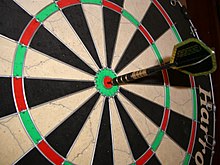Probability theory
Probability theory is the part of mathematics that studies random situations.[1][2][3][4][5][6] Probability theory usually studies random events, random variables, stochastic processes, and non-deterministic events (events that do not follow a simple pattern).

Tossing a coin, winning the lottery, or rolling a die are random events. However, random events have certain patterns, which can be studied and predicted, using probability theory.[2][3][4][5][6]
Scientists can use probability theory to obtain information about things that would be too complex to deal with,[2][3][4][5][6] like statistical mechanics.[7][8][9] Also, scientists discovered (in the 20th century) that atoms, and everything that we know, obeys something called quantum mechanics,[10][11][12] which uses lots of probability theory.
History
The theory of probability was created by Gerolamo Cardano, a medical doctor and gambler who tried to calculate his luck. Years later, Pierre de Fermat and Blaise Pascal helped develop Cardano's theory.
Today, probability theory is used in statistics, which is useful to all kinds of areas:[2][3][4][5][6] like medicine, economy, Science, Mathematics...
Related pages
Bibliography
- Pierre Simon de Laplace (1812). Analytical Theory of Probability.
- The first major treatise blending calculus with probability theory, originally in French: Théorie Analytique des Probabilités.
- Andrei Nikolajevich Kolmogorov (1950). Foundations of the Theory of Probability.
- The modern measure-theoretic foundation of probability theory; the original German version (Grundbegriffe der Wahrscheinlichkeitrechnung) appeared in 1933.
- Patrick Billingsley (1979). Probability and Measure. New York, Toronto, London: John Wiley and Sons.
- Henk Tijms (2004). Understanding Probability. Cambridge Univ. Press.
- A lively introduction to probability theory for the beginner.
- Gut, Allan (2005). Probability: A Graduate Course. Springer-Verlag. ISBN 0-387-22833-0.